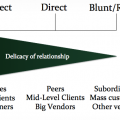Can you identify with this story?
Heather leads a team of Indians, and everything seems to be off to a great start. She meets with the whole team, sets out clear responsibilities, and makes sure everyone is clear on the common task. She schedules regular meetings to assess the progress so far, address issues, and praise good work. The project is going well, and everyone seems to be happy.
Then Heather gets her 360-degree feedback report:
- “She can be very rude and overbearing”
- “She gives too much importance to negative things, and doesn’t talk about the positive things we are doing”
- “She is very direct in speaking to us”
- “She does not agree with our suggestions”
- “I am afraid to bring up things in meetings when she is there”
Yikes! Less culturally sensitive people might say, “That’s the price you pay for results” or “People need to grow up and learn the way the business world works.”
But not you. (Or Heather.)
Getting a report like this would really bother you, and would keep you up at night. You think, “What could I have missed? Why didn’t I see this coming?” You would replay all the conversations and meetings in your head and struggle to find a reasonable answer.
If you resonate with this scenario, fear not. There might be an easy explanation.
Communication Comfort Zones
To start, let’s go back to Craig Storti’s communication spectrum:

Storti said each culture has a different definition for each of these terms (indirect/direct/rude), meaning that a German might define the word “rude” differently than an Indian would. I call each person’s spectrum a Communication Comfort Zone.
What you need to know about Communication Comfort Zones:
Each individual has a different Comfort Zone. It is not just national cultures that affect this, but also your personality, upbringing, education, first job experience, etc.
Comfort Zones might change with the mode of communication. You might be very bold in your emails or other written communication, but in person you don’t speak as forcefully and back off more often.
Individuals have varying lengths of Comfort Zones. On the diagram below, Satish has a very wide comfort zone and is comfortable with everything from very indirect to a little rude. On the other hand, Sharla is less comfortable with communication outside her narrow zone.

Westerners tend to justify the extremes of their Comfort Zones based on the context, whereas Indians (and most of the rest of the world) justify the extremes based on the relationship. If you come from the UK, it is ok for you to go to your extreme indirect side IF you are dealing with a very tricky and delicate situation. Similarly, you justify going to your extreme rude side IF it is a very intense meeting or IF someone did something very offensive. The context of the situation determines the correct action.
In India (and many other places), the more delicate the relationship, the more indirect your response should be. The less delicate, the more direct and rude you can be. It is ok to be extremely indirect IF you are speaking with the CEO. It is ok to be extremely direct IF you are speaking to a lower level staff person. Here, the relationship is always the first determinant for directness.
You judge others based on the Comfort Zone (and reasons for justification) you’ve developed. For example, let’s say someone uses a swear word in a meeting. Your judgment of the situation will first come from your own comfort zone (I would never have done that!), and second from your justification of the situation (western) or relationships involved (others). This is also true when judging if someone is being too indirect.
You can already see where communication conflicts are bound to occur. When you land in a new culture, if you are not aware that you might have a drastically different Comfort Zone from someone else, you will have problems.
Back to Heather…
That is likely what happened to Heather in our story. She came in with her own spectrum that was probably pretty far to the right, whereas her team members were aligned somewhere more to the left.

Small things like cutting people off in a conversation, focusing on the negative aspects first, and dealing with sensitive issues head-on can make her seem rude and unwelcoming in a culture where everything is aligned differently.
More Examples
Here are two more examples of communication conflicts that happen because of misaligned Communication Comfort Zones:
#1: Relationally, Ashish knows he is supposed to be indirect toward his supervisor, Alan. So when Alan presses Ashish to give his opinion of Alan’s latest whitepaper, Ashish leans towards the left side of his comfort zone. However, Ashish’s version of indirect doesn’t even register on Alan’s scale.
Alan is confused by Ashish’s behavior, which he associates with him trying to hide something (or lying). Alan starts to feel upset, which justifies his request for a “straight answer” using a firm voice. Alan’s firm style is off the charts on Ashish’s comfort zone, which makes him feel he has upset his superior and needs to be even more careful (and indirect).
#2: Trisha reports to Lovleen. During a meeting, Lovleen casually asks everyone at the table what they think about the new, initial-stage proposal put forward by another VP who is in the room. Trisha looks at the context and feels this is an appropriate time to demonstrate her smart, critical mind. She speaks up and points out some flaws in the proposal, and suggests where it will likely face problems. Now Trisha might get sidelined by others and not invited to these meetings because she is seen as too rude and blunt. She also might have made some enemies.
So what is the solution to all of this?
As a savvy intercultural communicator, there are two things you can do to prevent these conflicts from happening.
First, you should make yourself aware of the difference between justifying based on context and justifying based on relationship. This is a huge difference that most westerners do not understand when working with this side of the world. No matter how much you feel disrespected and abused by the CEO of a major company, there will never be a time when it is ok to speak in a rude tone to him. Those coming from outside the West must recognize that there are contexts where you can be direct with highly delicate relationships, AND also contexts where you should be indirect and sensitive with people lower on your delicacy scale.
Second, you should work on expanding your comfort zone, both in terms of giving and receiving information. To do this, determine where you think your personal comfort zone exists compared to others. Are you more indirect than others or more direct? Assess yourself within your home culture, and also compared to the culture you are working with. Also, compare your written communication to your verbal communication.
For myself, I know I am pretty comfortable with delivering and interpreting messages both in a very direct and very indirect way. However, my greatest areas to expand are in my verbal communication. I think I am being very subtle in how I say something, but it still comes across as very obvious to Indian colleagues. Similarly, I had a meeting with a lady from Germany where I realized I needed to push myself to be much more direct or else she might think of me as being inauthentic.
Once you have a guess as to where your growth areas are, you need to put yourself in situations where you can learn how to push yourself to be either more direct or indirect (depending on the context or relationship). In future articles, we’ll look specifically how to train yourself to deliver and receive indirect communication.
Having an extremely broad Communication Comfort Zone, along with understanding the relationship/context division, will make you an extremely skilled and valuable communicator around the world. People with this skillset:
- Get into less arguments
- Handle delicate situations better
- Notice potential dangers before they occur
- Get their message understood by the other person
- Don’t get offended easily
- Build better rapport
If you are this kind of communicator, you will be very refreshing to your international colleagues. I’ve heard seasoned Indian businessmen proudly claim, “Westerners really appreciate it when I am direct”. Similarly, Western leaders in India are often praised for not “bulldozing” their way through a team.
In upcoming articles, we’ll look at some ways to expand your comfort zone, and look more deeply at what indirect communication really is. Be sure to subscribe so that you don’t miss anything!





Not only is this series going to be a blessing to those in international relationships but also to those of us who find ourselves in the Western context only. I found myself thinking of meetings I have been in where I caused some kind of conflict because I didn’t understand these truths. Thank you for this enlightenment. I look forward to learning more.